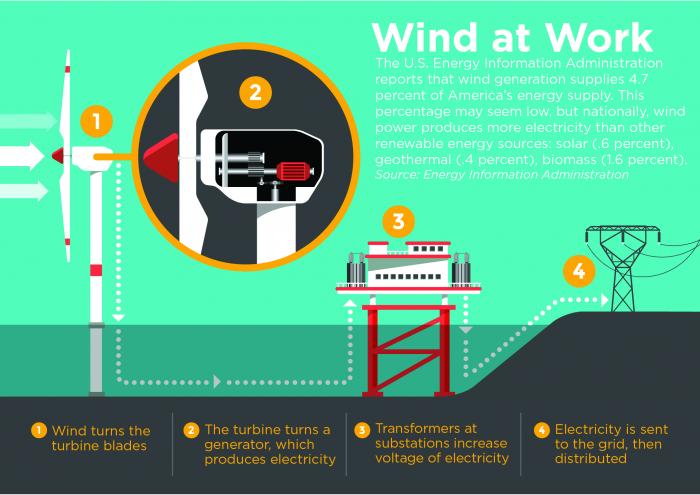The energy industry is changing. As technology has advanced, the use of renewable energy resources has grown. Many people express interest in producing energy through the use of solar panels, but you might be surprised to learn that wind is a much larger contributor to America’s diverse energy mix.
Wind accounts for 4.7 percent of our nation’s fuel mix, while solar power contributes just 0.6 percent, according to the U.S. Energy Information Administration.
In Texas, wind provides an even greater energy windfall. The state currently leads the nation in wind energy generation with more than 18,500 MW of installed wind capacity. That’s more than double the wind energy production of any other state. And growth in the industry doesn’t appear to be stopping. Another 5,040 MW is currently under construction.
In 2016, wind energy provided just over 12 percent of all electricity produced in Texas. That’s enough to power 4.1 million homes, according to the American Wind Energy Association.
San Patricio Electric Cooperative also purchases wind energy as part of the energy mix that is delivered to all of our members. All energy in SPEC’s mix comes from our generation and transmission cooperative, South Texas Electric Cooperative.
In 2015, STEC’s purchased 4.2 percent of its energy mix from the Penascal Wind Farm, a 168 turbine project located in Kenedy County. Of the energy produced at the Penascal Wind Farm, STEC purchases 100.8 MW.
How do wind turbines work?

With so many wind turbines in Texas, you’ve probably seen your fair share. But have you ever wondered how those spinning blades create energy?
Wind farms are typically located in areas that consistently get 13 mph winds or higher. At this speed, the wind pushes the blades of the turbine, which are connected to a generator via a gear box. These parts are contained in a housing unit called a nacelle. The mechanical connection increases the revolutions of the blades from a leisurely 15-20 revolutions per minute to 1,800 RPM at the generator, where wind becomes electricity.
Once the wind changes direction, the nacelle turns the blades to continue generating energy. When wind farms are built, turbines are strategically placed so the turbulence from one does not affect the operation of the others behind it. Turbines are also built with protective mechanisms that will furl the blades once a certain wind speed is reached to prevent the turbine from spinning itself into pieces.
Wind turbines are built with three blades—a number that balances output with cost effectiveness. Turbines with one blade have been deemed unstable. Adding a second blade increases energy output by 10 percent. A third blade increases output by another 5 percent. Although adding more blades would increase the output further, the increase would be minimal and wouldn’t outweigh the cost of materials and construction.
The largest blade being produced today is 75 meters in length, almost the wingspan of an Airbus A380. Although they may seem slow-turning, the tips of these long blades can move at 180 mph.
A key challenge facing wind energy is variability. The output of a wind turbine varies significantly from day to day, making it an inconsistent power source. For now, wind energy is best deployed as part of a diverse energy portfolio, which includes stable generating resources, such as natural gas and coal.
